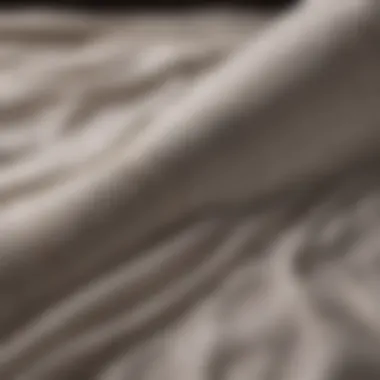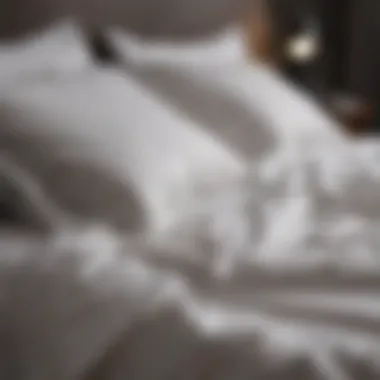Determining the Optimal Thread Count for Duvet Covers


Intro
Choosing the right duvet cover involves more than just aesthetics; it is about understanding how thread count plays a vital role in comfort and durability. Thread count is the number of threads woven together per square inch of fabric. This measurement influences not only the feel but also the longevity and overall quality of the duvet cover.
In this article, we will explore the optimal thread counts suitable for various materials and preferences. We'll shed light on misconceptions regarding thread counts, guiding readers through how to assess the quality of duvet covers beyond mere numbers. This knowledge aims to enhance the quality of sleep and elevate the sleeping environment, fitting the ethos of LuxeYardDesigns.
Understanding Thread Count
Thread count can influence the tactile experience of a duvet cover. It is commonly thought that higher thread counts mean better quality. However, this notion can be misleading. While a thread count of 300 to 500 is ideal for cotton duvet covers, materials such as linen or bamboo might perform better with lower counts due to their unique weaving methods.
Misconceptions About Thread Count
Many believe that thread counts reaching 1000 or more are the gold standard. However, such high counts might simply result from multi-ply yarns or deceptive marketing practices. Important aspects of duvet covers, such as material type and weave pattern, can strongly affect performance.
"Quality of fabric is essential; thread count alone does not determine it."
The Impact of Material Type
When examining duvet covers, it is crucial to consider material types alongside thread count. Each fabric offers unique properties. For example, cotton is breathable and soft, while silk provides a luxurious feel. Higher thread counts in silk may not yield the same benefits as cotton.
Ideal Thread Counts by Material
- Cotton: 300 - 500
- Egyptian Cotton: 400 - 600
- Linen: 80 - 200
- Silk: 400 - 600
- Bamboo: 300 - 400
Each of these ranges reflects the material's capacity for comfort and durability.
Assessing Quality Beyond Thread Count
When purchasing duvet covers, consider additional factors to gauge quality. Pay attention to the weave, finish, and the manufacturer's reputation.
Key Quality Indicators
- Weave Type: Sateen and percale are popular weaves, each offering different feels and durability.
- Durability: Look for double-stitched seams and quality craftsmanship.
- Manufacturer Transparency: Brands that disclose their sourcing and manufacturing processes often produce more reliable products.
Culmination
Selecting the optimal thread count for duvet covers is a nuanced process. It requires understanding the interplay between thread count, material type, and overall quality indicators. Armed with this knowledge, readers can make informed choices that align with their comfort preferences, promoting better sleep and overall well-being.
Understanding Thread Count
Thread count plays a crucial role when selecting duvet covers. It serves as an indicator of fabric quality and directly affects comfort and durability. Individuals often find themselves overwhelmed by the sheer volume of information available about duvet covers. Grasping the concept of thread count simplifies this process, allowing individuals to make informed decisions. Understanding thread count can help one navigate the marketplace more effectively and find the perfect duvet cover that aligns with personal preferences.
Definition of Thread Count
Thread count refers to the total number of horizontal and vertical threads woven into one square inch of fabric. This number incorporates two components: the warp (vertical threads) and the weft (horizontal threads). High thread count is often associated with softness and quality. However, definitions can vary across different types of fabrics. For instance, cotton, linen, and polyester all offer different nuances in how thread count is perceived. Thus, accurately evaluating thread count requires consideration of the fabric's type and weave.
How Thread Count is Measured


Measuring thread count is not a complicated task. Most manufacturers determine it using a straightforward counting method. They take a fabric swatch, place it under a magnifying glass, and count the threads in one square inch. However, not all measurements are equal. Manufacturers might count multi-ply threads multiple times, which can inflating the overall count. This practice can mislead consumers into believing they are purchasing higher-quality fabric.
Impact on Fabric Feel
The impact of thread count on fabric feel is significant. A higher thread count generally results in a denser fabric that can feel softer against the skin. Fabrics with lower thread counts may be less durable but can still provide comfort in other ways, like breathability. It is essential to note that an extremely high thread count does not always guarantee a better product. Sometimes, a lower count in a quality fabric can outperform a higher count in a synthetic variant. Therefore, when considering thread count, one should evaluate comfort in conjunction with overall fabric quality.
"The right thread count aligns with both personal comfort and material expectations."
Understanding these subtleties can greatly influence your choice in duvet covers, enhancing the sleep experience.
The Ideal Thread Count Range
Understanding the concept of thread count is essential for making informed choices when selecting duvet covers. The thread count affects not only the feel but also the durability and overall quality of the fabric. When delving into the ideal thread count range, it is beneficial to know how thread count impacts comfort and how it varies concerning different materials. Choosing the right thread count helps in aligning personal preferences with practical considerations, such as the warmth or breathability needed for a good night’s sleep.
Basics of Duvet Cover Thread Counts
Thread count refers to the number of threads woven into one square inch of fabric. Generally, more threads mean a tighter weave, which can indicate a softer fabric. However, this isn't a strict rule. A high thread count alone does not guarantee better quality. It is important to consider the quality of the threads and the type of fabric. Generally, a thread count of 300 to 600 is often recommended for duvet covers, balancing softness with durability.
Luxury vs. Budget Options
When choosing duvet covers, one may encounter a significant range in pricing caused by differences in thread count and fabric quality. Luxury duvet covers often have higher thread counts, providing a softer and more delicate feel. These options may also feature natural fibers, which tend to be more breathable compared to synthetic ones. On the other hand, budget options may still offer reasonable thread counts but often use lower-quality fibers, which can affect the overall sleep experience. Therefore, the decision between luxury and budget should weigh both financial considerations and desired comfort levels.
Optimal Ranges by Material
Cotton
Cotton is a favored choice for duvet covers due to its breathability and softness. A thread count between 300 and 500 is often optimal for cotton fabrics. This range ensures that the duvet cover feels plush without compromising on durability. Cotton's unique property to wick moisture away also adds to its popularity as it promotes a comfortable sleep environment.
Polyester
Polyester duvet covers are known for their affordability and ease of care. Typically, a thread count between 200 and 300 provides adequate comfort. While not as breathable as cotton, polyester retains its shape well and dries quickly. However, it may not be as soft as natural fibers, and thus, comfort may be subjective based on individual preferences.
Blends
Blended fabrics, often made from both cotton and synthetic fibers, offer a balance of comfort and durability. A thread count of about 250 to 400 allows these blends to provide a soft feel while remaining affordable. Blends usually combine the breathability of cotton with the wrinkle-resistance of polyester. This versatility makes blends a compelling choice for practical homeowners.
Linen
Linen duvet covers typically have a lower thread count due to the nature of the fiber. A range of 150 to 300 is common, emphasizing durability and a unique texture. Linen is highly absorbent and breathable, making it ideal for hot climates. Its natural properties allow for improved airflow, and while it may wrinkle easily, many appreciate its relaxed aesthetic.
Choosing the right thread count based on the material helps in achieving the desired balance of comfort, durability, and functionality in duvet covers.
Debunking Common Myths
In the quest for the perfect duvet cover, many misconceptions circulate about thread count. This section aims to clarify these misunderstandings, guiding readers toward a more informed approach when shopping for duvet covers. Misconceptions can lead to poor choices, affecting comfort and satisfaction. Understanding the truth behind common thread count myths ensures a more rewarding experience in selecting and using duvet covers.
Higher Thread Count Equals Better Quality
A prevalent belief is that a higher thread count automatically means superior quality. While thread count plays a role in the feel of the fabric, it is not the sole indicator of quality. A cover with a thread count of 1000 might seem impressive, but if the material is of poor quality, the duvet cover will not perform well.


Key aspects to consider include:
- Material Type: The fiber quality matters significantly. A high-quality cotton or linen can outperform a synthetic fabric even at a lower thread count.
- Weave Technique: Different weaving methods can enhance or diminish the overall texture and durability. For instance, sateen may feel luxurious with a lower thread count compared to percale with a high thread count.
Overall, looking beyond just thread count allows consumers to gauge quality more effectively.
Thread Count and Durability
Another myth suggests that a higher thread count ensures greater durability. While it may seem logical, durability is influenced by more than just how many threads are packed into a square inch.
To better understand this:
- Fiber Strength: The actual strength of the fibers used matters. For example, Egyptian cotton is known for its long and strong fibers, which can enhance durability despite a lower thread count.
- Manufacturing Process: The production techniques impact how fabrics hold up over time. Poorly made fabrics, regardless of thread count, will wear out quickly.
A balance between thread count and the quality of production is essential for durability in duvet covers.
Fabric Type vs. Thread Count
It is vital to differentiate between fabric type and thread count when selecting duvet covers. The type of fabric influences not only the feel but also the overall performance of the duvet. Some materials naturally require different thread counts for optimal feel.
Important points to consider include:
- Cotton: Generally, a thread count of 400 to 600 works well for cotton duvet covers, providing a soft yet robust feel.
- Silk: For silk, a lower count can still deliver a luxurious touch due to the fiber's natural softness.
- Polyester Blends: These may perform well even at lower thread counts, offering a budget-friendly option that can mimic higher-end fabrics.
Understanding the relationship between fabric types and thread counts is critical for a suitable choice that meets individual preferences for comfort and quality.
Factors Influencing Comfort and Quality
When considering duvet covers, it is essential to understand the factors that influence both comfort and quality. These elements extend beyond just thread count, impacting how the material feels against the skin and its longevity. A comprehensive grasp of these factors can aid in selecting the most suitable duvet cover for your needs.
Material Quality
The quality of the material used in duvet covers is a key determinant of comfort. Fabrics like Egyptian cotton are renowned for their softness and durability. In contrast, lower-quality materials, such as blended fabrics, might not offer the same level of comfort. The origin of cotton, thread finish, and manufacturing process contribute to the overall experience. Better-quality materials tend to breathe well, preventing overheating during sleep. This is particularly beneficial in warmer climates or for individuals who naturally run hot while sleeping.
Weave Type
Weaving techniques significantly affect how a duvet cover feels and performs. For instance, a percale weave is known for its crispness and breathability, making it ideal for hot sleepers. On the other hand, a sateen weave offers a smoother and silkier feel, which can enhance the luxurious aspect of the duvet cover. Choosing the right weave can improve comfort but also influence how well the duvet cover retains its shape and durability over time. A good weave usually supports a higher thread count, enhancing the overall aesthetic quality without sacrificing comfort.
Environmental Considerations
In today's climate-conscious world, environmental considerations cannot be overlooked. The production processes of certain materials can have a significant impact on the planet. Organic cotton duvet covers, for example, are produced without harmful pesticides and chemicals. This not only contributes to a healthier environment but often ensures a higher quality fabric for consumers. Additionally, examining certifications such as the Global Organic Textile Standard (GOTS) can provide insight into environmentally friendly practices. Making an informed choice regarding materials can lead to better-quality sleep while also promoting sustainability.
"Understanding the quality of the material, the type of weave, and environmental impact will guide you to the best duvet cover for your personal needs."
In summary, while thread count is an important metric, focusing on these underlying factors will enhance overall comfort and quality. Being mindful of material quality, weave types, and environmental impact can elevate your bedding experience in multiple dimensions.
Shopping Tips for Duvet Covers
When selecting duvet covers, making informed decisions is crucial. A well-chosen duvet cover can elevate not only decor but also the quality of sleep. Understanding what to consider when shopping empowers buyers to choose wisely, maximizing value and comfort.


What to Look for in Labels
Reading labels is essential. Labels provide vital information about the duvet cover’s material, thread count, and care instructions. Pay attention to:
- Material Composition: Cotton, linen, or blends? Each material has unique properties that affect comfort and durability. Choose according to your needs.
- Thread Count: Higher isn’t always better. Aim for a range that matches your preference, such as 300-600 for a silky feel while remaining breathable.
- Care Guidelines: Some materials require special washing. Ensure ease of maintenance when purchasing.
Look for labels that provide clear, concise information. Avoid those that lack detail or mislead about thread count.
Understanding Certifications
Certification can help ensure a quality product. Recognized standards indicate that the duvet cover meets certain criteria for safety and sustainability. Look for certifications such as:
- OEKO-TEX Standard 100: Assures that textiles are free from harmful substances.
- GOTS (Global Organic Textile Standard): Certifies organic production and environmentally friendly practices.
Checking for these certifications contributes to confident purchases and promotes responsible consumer behavior.
Where to Buy Quality Duvet Covers
Identifying the best retailers is part of the shopping strategy. Quality duvet covers are available in various places:
- Specialty Bedding Stores: Often provide a curated selection with knowledgeable staff.
- Online Retailers: Websites like Amazon or Wayfair offer convenience and filters for shopping. Be sure to check customer reviews.
- Department Stores: Try physical stores like Macy's or Nordstrom for firsthand examination of the material and quality.
Be cautious of overly cheap options. Quality often correlates with price, so assess your budget accordingly.
A thorough inspection of labels, certifications, and retailers leads to more satisfying purchases. Take your time, and choose wisely.
Caring for Duvet Covers
Caring for duvet covers is crucial for maintaining their quality and extending their lifespan. Duvet covers not only protect the duvet itself but also contribute significantly to your sleeping experience. Proper care ensures that they remain fresh, free from allergens, and visually appealing. Neglecting this can lead to wear and tear, resulting in an unnecessary replacement that might disrupt the budget.
Washing and Maintenance Tips
It's important to follow washing guidelines to preserve the integrity of duvet covers. Here are key points to consider:
- Read care labels: Start with the label instructions. Each duvet cover has recommended washing methods that can vary based on material and thread count.
- Use cold water: Washing in cold water helps prevent shrinkage and fading. This option is suitable for most materials while maintaining color and texture.
- Gentle detergent: Select a mild detergent that has no harsh chemicals. This will protect the fabric from damage and maintain its softness.
- Wash in a large machine: If possible, wash duvet covers in a large-capacity machine. Overcrowding can lead to uneven cleaning and fabric stress.
- Drying methods: Consider using a low-heat setting in the dryer. For natural fibers like cotton or linen, air drying is often the safer choice to avoid high-heat damage.
Storing Duvet Covers Properly
When it comes to storage, the way duvet covers are stored impacts their longevity. It is best to ensure that they remain in pristine condition. Here’s how to store them effectively:
- Clean before storage: Always wash and dry duvet covers before storing them. This helps prevent mold and mildew from developing.
- Use breathable bags: Store duvet covers in cotton or breathable fabric bags. Avoid plastic, as it can trap moisture and lead to mold growth.
- Keep in a cool, dry place: Choose a storage location that is cool and dry. Heat and humidity can degrade the fabric.
- Avoid direct sunlight: Prolonged exposure to sunlight can fade colors and weaken fibers. Choose a dark storage environment for better preservation.
- Check periodically: Make it a habit to check on stored duvet covers occasionally. This will help detect any potential issues like moisture or pests.
Proper care and storage not only enhance the appearance of duvet covers but also maximize your investment. A little attention goes a long way in ensuring their quality over the years.
Closure
When selecting a duvet cover, one must pay attention not only to the thread count but also to how it aligns with personal preferences and specific materials. For instance, a cotton duvet cover with a thread count of 300 may offer better breathability and softness than a polyester one with a higher count.
Benefits of Understanding Thread Count
- Enhanced Comfort: Knowing the optimal thread count helps in making informed choices that support better sleep quality.
- Durability Insight: Thread count can indicate how well a duvet cover will hold up after repeated washes, although it is not the only determinant.
- Economic Value: Understanding the relationship between thread count and quality can lead to smarter purchasing decisions that offer lasting value.
Considerations to Bear in Mind
- Material Matters: Not all fibers react the same way to changes in thread count. Cotton, for instance, has different comfort offerings compared to synthetic blends.
- Personal Preference: Some people might prefer crisp linens, while others enjoy the silky feel of higher-thread-count fabrics.
- Misconceptions: Many myths surround thread count. It is critical to navigate these to avoid overpaying for misleading benefits.















